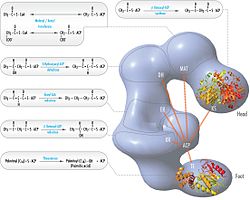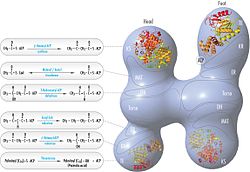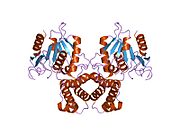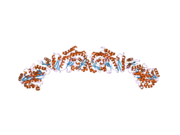Fatty acid synthase
| Fatty acid synthase | |||||||||
|---|---|---|---|---|---|---|---|---|---|
| Identifiers | |||||||||
| EC no. | 2.3.1.85 | ||||||||
| CAS no. | 9045-77-6 | ||||||||
| Databases | |||||||||
| IntEnz | IntEnz view | ||||||||
| BRENDA | BRENDA entry | ||||||||
| ExPASy | NiceZyme view | ||||||||
| KEGG | KEGG entry | ||||||||
| MetaCyc | metabolic pathway | ||||||||
| PRIAM | profile | ||||||||
| PDBstructures | RCSB PDBPDBePDBsum | ||||||||
| Gene Ontology | AmiGO/QuickGO | ||||||||
| |||||||||
| fatty acid synthase | |||||||||||||||||||||||||||||||||||||||||||||||||||
|---|---|---|---|---|---|---|---|---|---|---|---|---|---|---|---|---|---|---|---|---|---|---|---|---|---|---|---|---|---|---|---|---|---|---|---|---|---|---|---|---|---|---|---|---|---|---|---|---|---|---|---|
| Identifiers | |||||||||||||||||||||||||||||||||||||||||||||||||||
| Aliases | fatty acid synthases | ||||||||||||||||||||||||||||||||||||||||||||||||||
| External IDs | GeneCards:[1];OMA:- orthologs | ||||||||||||||||||||||||||||||||||||||||||||||||||
| |||||||||||||||||||||||||||||||||||||||||||||||||||
| Wikidata | |||||||||||||||||||||||||||||||||||||||||||||||||||
| |||||||||||||||||||||||||||||||||||||||||||||||||||
Fatty acid synthase(FAS)[1]is anenzymethat in humans is encoded by theFASNgene.[2][3][4][5]
Fatty acid synthase is a multi-enzymeproteinthat catalyzesfatty acid synthesis.It is not a singleenzymebut a whole enzymatic system composed of two identical 272 kDa multifunctionalpolypeptides,in whichsubstratesare handed from one functional domain to the next.[1][6][7][8][9]
Its main function is to catalyze the synthesis ofpalmitate(C16:0, a long-chainsaturated fatty acid) fromacetyl-CoAandmalonyl-CoA,in the presence ofNADPH.[5]
The fatty acids are synthesized by a series of decarboxylativeClaisen condensationreactions fromacetyl-CoAandmalonyl-CoA.Following each round of elongation the beta keto group is reduced to the fully saturated carbon chain by the sequential action of aketoreductase(KR),dehydratase(DH), andenoyl reductase(ER). The growing fatty acid chain is carried between these active sites while attached covalently to the phosphopantetheine prosthetic group of anacyl carrier protein(ACP), and is released by the action of athioesterase(TE) upon reaching a carbon chain length of 16 (palmitic acid).[1]
Classes[edit]
There are two principal classes of fatty acid synthases.
- Type I systems utilise a single large, multifunctional polypeptide and are common to bothanimalsandfungi(although the structural arrangement of fungal and animal syntheses differ). A Type I fatty acid synthase system is also found in the CMN group of bacteria (corynebacteria,mycobacteria,andnocardia). In these bacteria, the FAS I system produces palmitic acid, and cooperates with the FAS II system to produce a greater diversity of lipid products.[10]
- Type II is found in archaea, bacteria and plant plastids, and is characterized by the use of discrete, monofunctional enzymes for fatty acid synthesis. Inhibitors of this pathway (FASII) are being investigated as possibleantibiotics.[11]
The mechanism of FAS I and FAS II elongation and reduction is the same, as the domains of the FAS II enzymes are largely homologous to their domain counterparts in FAS I multienzyme polypeptides. However, the differences in the organization of the enzymes - integrated in FAS I, discrete in FAS II - gives rise to many important biochemical differences.[12]
The evolutionary history of fatty acid synthases are very much intertwined with that ofpolyketide synthases(PKS). Polyketide synthases use a similar mechanism and homologous domains to produce secondary metabolite lipids. Furthermore, polyketide synthases also exhibit a Type I and Type II organization. FAS I in animals is thought to have arisen through modification of PKS I in fungi, whereas FAS I in fungi and the CMN group of bacteria seem to have arisen separately through the fusion of FAS II genes.[10]
Structure[edit]
Mammalian FAS consists of a homodimer of two identical protein subunits, in which threecatalyticdomains in theN-terminalsection (-ketoacyl synthase (KS), malonyl/acetyltransferase (MAT), and dehydrase (DH)), are separated by a core region (known as the interdomain) of 600 residues from fourC-terminaldomains (enoyl reductase (ER), -ketoacyl reductase (KR), acyl carrier protein (ACP) and thioesterase (TE)).[13][14]The interdomain region allows the two monomeric domains to form a dimer.[13]
The conventional model for organization of FAS (see the 'head-to-tail' model on the right) is largely based on the observations that the bifunctional reagent 1,3-dibromopropanone (DBP) is able to crosslink the active sitecysteinethiol of the KS domain in one FAS monomer with thephosphopantetheineprosthetic group of the ACP domain in the other monomer.[15][16]Complementation analysis of FAS dimers carrying different mutations on each monomer has established that the KS and MAT domains can cooperate with the ACP of either monomer.[17][18]and a reinvestigation of the DBP crosslinking experiments revealed that the KS active site Cys161 thiol could be crosslinked to the ACP 4'-phosphopantetheinethiol of either monomer.[19]In addition, it has been recently reported that aheterodimericFAS containing only one competent monomer is capable of palmitate synthesis.[20]
The above observations seemed incompatible with the classical 'head-to-tail' model for FAS organization, and an alternative model has been proposed, predicting that the KS and MAT domains of both monomers lie closer to the center of the FAS dimer, where they can access the ACP of either subunit (see figure on the top right).[21]
A low resolution X-ray crystallography structure of both pig (homodimer)[22]and yeast FAS (heterododecamer)[23]along with a ~6 Å resolution electron cryo-microscopy (cryo-EM) yeast FAS structure[24]have been solved.
Substrate shuttling mechanism[edit]
The solved structures of yeast FAS and mammalian FAS show two distinct organizations of highly conserved catalytic domains/enzymes in this multi-enzyme cellular machine. Yeast FAS has a highly efficient rigid barrel-like structure with 6 reaction chambers which synthesize fatty acids independently, while the mammalian FAS has an open flexible structure with only two reaction chambers. However, in both cases the conserved ACP acts as the mobile domain responsible for shuttling the intermediate fatty acid substrates to various catalytic sites. A first direct structural insight into this substrate shuttling mechanism was obtained by cryo-EM analysis, where ACP is observed bound to the various catalytic domains in the barrel-shaped yeast fatty acid synthase.[24]The cryo-EM results suggest that the binding of ACP to various sites is asymmetric and stochastic, as also indicated by computer-simulation studies[25]
 |
 |
Regulation[edit]
Metabolismandhomeostasisof fatty acid synthase is transcriptionally regulated by Upstream Stimulatory Factors (USF1andUSF2) andsterol regulatory element binding protein-1c (SREBP-1c) in response to feeding/insulin in living animals.[26][27]
Althoughliver X receptors(LXRs) modulate the expression ofsterol regulatory element binding protein-1c (SREBP-1c) in feeding, regulation of FAS by SREBP-1c is USF-dependent.[27][28][29][30]
Acylphloroglucinolsisolated from the fernDryopteris crassirhizomashow a fatty acid synthase inhibitory activity.[31]
Clinical significance[edit]
TheFASNgene has been investigated as a possibleoncogene.[32]FAS isupregulatedin breast and gastric cancers, as well as being an indicator of poor prognosis, and so may be worthwhile as a chemotherapeutic target.[33][34][35]FASinhibitorsare therefore an active area ofdrug discoveryresearch.[36][37][38][39][40]
FAS may also be involved in the production of an endogenousligandfor the nuclear receptorPPARalpha,the target of thefibratedrugs for hyperlipidemia,[41]and is being investigated as a possible drug target for treating the metabolic syndrome.[42]Orlistatwhich is a gastrointestinal lipase inhibitor also inhibits FAS and has apotential as a medicine for cancer.[43][44]
In some cancer cell lines, this protein has been found to be fused withestrogen receptor alpha(ER-alpha), in which theN-terminusof FAS is fused in-frame with theC-terminusof ER-alpha.[5]
An association withuterine leiomyomatahas been reported.[45]
See also[edit]
- Discovery and development of gastrointestinal lipase inhibitors
- Fatty acid synthesis
- Fatty acid metabolism
- Fatty acid degradation
- Enoyl-acyl carrier protein reductase
- List of fatty acid metabolism disorders
References[edit]
- ^abcPaiva P, Medina FE, Viegas M, Ferreira P, Neves RP, Sousa JP, Ramos MJ, Fernandes PA (2021-08-11)."Animal Fatty Acid Synthase: A Chemical Nanofactory".Chemical Reviews.121(15): 9502–9553.doi:10.1021/acs.chemrev.1c00147.ISSN0009-2665.PMID34156235.S2CID235595027.
- ^Jayakumar A, Chirala SS, Chinault AC, Baldini A, Abu-Elheiga L, Wakil SJ (February 1995). "Isolation and chromosomal mapping of genomic clones encoding the human fatty acid synthase gene".Genomics.23(2): 420–424.doi:10.1006/geno.1994.1518.PMID7835891.
- ^Jayakumar A, Tai MH, Huang WY, al-Feel W, Hsu M, Abu-Elheiga L, Chirala SS, Wakil SJ (Oct 1995)."Human fatty acid synthase: properties and molecular cloning".Proceedings of the National Academy of Sciences of the United States of America.92(19): 8695–8699.Bibcode:1995PNAS...92.8695J.doi:10.1073/pnas.92.19.8695.PMC41033.PMID7567999.
- ^Persson B, Kallberg Y, Bray JE, Bruford E, Dellaporta SL, Favia AD, Duarte RG, Jörnvall H, Kavanagh KL, Kedishvili N, Kisiela M, Maser E, Mindnich R, Orchard S, Penning TM, Thornton JM, Adamski J, Oppermann U (Feb 2009)."The SDR (short-chain dehydrogenase/reductase and related enzymes) nomenclature initiative".Chemico-Biological Interactions.178(1–3): 94–98.Bibcode:2009CBI...178...94P.doi:10.1016/j.cbi.2008.10.040.PMC2896744.PMID19027726.
- ^abc"Entrez Gene: FASN fatty acid synthase".
- ^Alberts AW, Strauss AW, Hennessy S, Vagelos PR (October 1975)."Regulation of synthesis of hepatic fatty acid synthetase: binding of fatty acid synthetase antibodies to polysomes".Proceedings of the National Academy of Sciences of the United States of America.72(10): 3956–3960.Bibcode:1975PNAS...72.3956A.doi:10.1073/pnas.72.10.3956.PMC433116.PMID1060077.
- ^Stoops JK, Arslanian MJ, Oh YH, Aune KC, Vanaman TC, Wakil SJ (May 1975)."Presence of two polypeptide chains comprising fatty acid synthetase".Proceedings of the National Academy of Sciences of the United States of America.72(5): 1940–1944.Bibcode:1975PNAS...72.1940S.doi:10.1073/pnas.72.5.1940.PMC432664.PMID1098047.
- ^Smith S, Agradi E, Libertini L, Dileepan KN (April 1976)."Specific release of the thioesterase component of the fatty acid synthetase multienzyme complex by limited trypsinization".Proceedings of the National Academy of Sciences of the United States of America.73(4): 1184–1188.Bibcode:1976PNAS...73.1184S.doi:10.1073/pnas.73.4.1184.PMC430225.PMID1063400.
- ^Smith S, Witkowski A, Joshi AK (July 2003). "Structural and functional organization of the animal fatty acid synthase".Progress in Lipid Research.42(4): 289–317.doi:10.1016/S0163-7827(02)00067-X.PMID12689621.
- ^abJenke-Kodama H, Sandmann A, Müller R, Dittmann E (October 2005)."Evolutionary implications of bacterial polyketide synthases".Molecular Biology and Evolution.22(10): 2027–2039.doi:10.1093/molbev/msi193.PMID15958783.
- ^Fulmer T (March 2009)."Not so FAS".Science-Business EXchange.2(11): 430.doi:10.1038/scibx.2009.430.
- ^Stevens L, Price NC (1999).Fundamentals of enzymology: the cell and molecular biology of catalytic proteins.Oxford [Oxfordshire]: Oxford University Press.ISBN978-0-19-850229-6.
- ^abChirala SS, Jayakumar A, Gu ZW, Wakil SJ (March 2001)."Human fatty acid synthase: role of interdomain in the formation of catalytically active synthase dimer".Proceedings of the National Academy of Sciences of the United States of America.98(6): 3104–3108.Bibcode:2001PNAS...98.3104C.doi:10.1073/pnas.051635998.PMC30614.PMID11248039.
- ^Smith S (December 1994)."The animal fatty acid synthase: one gene, one polypeptide, seven enzymes".FASEB Journal.8(15): 1248–1259.doi:10.1096/fasebj.8.15.8001737.PMID8001737.S2CID22853095.
- ^Stoops JK, Wakil SJ (May 1981)."Animal fatty acid synthetase. A novel arrangement of the beta-ketoacyl synthetase sites comprising domains of the two subunits".Journal of Biological Chemistry.256(10): 5128–5133.doi:10.1016/S0021-9258(19)69376-2.PMID6112225.
- ^Stoops JK, Wakil SJ (March 1982)."Animal fatty acid synthetase. Identification of the residues comprising the novel arrangement of the beta-ketoacyl synthetase site and their role in its cold inactivation".Journal of Biological Chemistry.257(6): 3230–3235.doi:10.1016/S0021-9258(19)81100-6.PMID7061475.
- ^Joshi AK, Rangan VS, Smith S (February 1998)."Differential affinity labeling of the two subunits of the homodimeric animal fatty acid synthase allows isolation of heterodimers consisting of subunits that have been independently modified".Journal of Biological Chemistry.273(9): 4937–4943.doi:10.1074/jbc.273.9.4937.PMID9478938.
- ^Rangan VS, Joshi AK, Smith S (September 2001). "Mapping the functional topology of the animal fatty acid synthase by mutant complementation in vitro".Biochemistry.40(36): 10792–18799.doi:10.1021/bi015535z.PMID11535054.
- ^Witkowski A, Joshi AK, Rangan VS, Falick AM, Witkowska HE, Smith S (April 1999)."Dibromopropanone cross-linking of the phosphopantetheine and active-site cysteine thiols of the animal fatty acid synthase can occur both inter- and intrasubunit. Reevaluation of the side-by-side, antiparallel subunit model".Journal of Biological Chemistry.274(17): 11557–11563.doi:10.1074/jbc.274.17.11557.PMID10206962.
- ^Joshi AK, Rangan VS, Witkowski A, Smith S (February 2003)."Engineering of an active animal fatty acid synthase dimer with only one competent subunit".Chemistry and Biology.10(2): 169–173.doi:10.1016/S1074-5521(03)00023-1.PMID12618189.
- ^Asturias FJ, Chadick JZ, Cheung IK, Stark H, Witkowski A, Joshi AK, Smith S (March 2005). "Structure and molecular organization of mammalian fatty acid synthase".Nature Structural and Molecular Biology.12(3): 225–232.doi:10.1038/nsmb899.PMID15711565.S2CID6132878.
- ^Maier T, Leibundgut M, Ban N (September 2008). "The crystal structure of a mammalian fatty acid synthase".Science.321(5894): 1315–1322.Bibcode:2008Sci...321.1315M.doi:10.1126/science.1161269.PMID18772430.S2CID3168991.
- ^Lomakin IB, Xiong Y, Steitz TA (April 2007)."The crystal structure of yeast fatty acid synthase, a cellular machine with eight active sites working together".Cell.129(2): 319–332.doi:10.1016/j.cell.2007.03.013.PMID17448991.S2CID8209424.
- ^abGipson P, Mills DJ, Wouts R, Grininger M, Vonck J, Kühlbrandt W (May 2010)."Direct structural insight into the substrate-shuttling mechanism of yeast fatty acid synthase by electron cryomicroscopy".Proceedings of the National Academy of Sciences of the United States of America.107(20): 9164–9169.Bibcode:2010PNAS..107.9164G.doi:10.1073/pnas.0913547107.PMC2889056.PMID20231485.
- ^Anselmi C, Grininger M, Gipson P, Faraldo-Gómez JD (September 2010). "Mechanism of substrate shuttling by the acyl-carrier protein within the fatty acid mega-synthase".Journal of the American Chemical Society.132(35): 12357–12364.doi:10.1021/ja103354w.PMID20704262.
- ^Paulauskis JD, Sul HS (January 1989)."Hormonal regulation of mouse fatty acid synthase gene transcription in liver".Journal of Biological Chemistry.264(1): 574–577.doi:10.1016/S0021-9258(17)31298-X.PMID2535847.
- ^abLatasa MJ, Griffin MJ, Moon YS, Kang C, Sul HS (August 2003)."Occupancy and function of the -150 sterol regulatory element and -65 E-box in nutritional regulation of the fatty acid synthase gene in living animals".Molecular and Cellular Biology.23(16): 5896–5907.doi:10.1128/MCB.23.16.5896-5907.2003.PMC166350.PMID12897158.
- ^Griffin MJ, Wong RH, Pandya N, Sul HS (February 2007)."Direct interaction between USF and SREBP-1c mediates synergistic activation of the fatty-acid synthase promoter".Journal of Biological Chemistry.282(8): 5453–5467.doi:10.1074/jbc.M610566200.PMID17197698.
- ^Yoshikawa T, Shimano H, Amemiya-Kudo M, Yahagi N, Hasty AH, Matsuzaka T, Okazaki H, Tamura Y, Iizuka Y, Ohashi K, Osuga J, Harada K, Gotoda T, Kimura S, Ishibashi S, Yamada N (May 2001)."Identification of liver X receptor-retinoid X receptor as an activator of the sterol regulatory element-binding protein 1c gene promoter".Molecular and Cellular Biology.21(9): 2991–3000.doi:10.1128/MCB.21.9.2991-3000.2001.PMC86928.PMID11287605.
- ^Repa JJ, Liang G, Ou J, Bashmakov Y, Lobaccaro JM, Shimomura I, Shan B, Brown MS, Goldstein JL, Mangelsdorf DJ (November 2000)."Regulation of mouse sterol regulatory element-binding protein-1c gene (SREBP-1c) by oxysterol receptors, LXRalpha and LXRbeta".Genes & Development.14(22): 2819–2830.doi:10.1101/gad.844900.PMC317055.PMID11090130.
- ^Na M, Jang J, Min BS, Lee SJ, Lee MS, Kim BY, Oh WK, Ahn JS (September 2006). "Fatty acid synthase inhibitory activity of acylphloroglucinols isolated from Dryopteris crassirhizoma".Bioorganic & Medicinal Chemistry Letters.16(18): 4738–4742.doi:10.1016/j.bmcl.2006.07.018.PMID16870425.
- ^Baron A, Migita T, Tang D, Loda M (January 2004). "Fatty acid synthase: a metabolic oncogene in prostate cancer?".Journal of Cellular Biochemistry.91(1): 47–53.doi:10.1002/jcb.10708.PMID14689581.S2CID26175683.
- ^Hunt DA, Lane HM, Zygmont ME, Dervan PA, Hennigar RA (2007). "MRNA stability and overexpression of fatty acid synthase in human breast cancer cell lines".Anticancer Research.27(1A): 27–34.PMID17352212.
- ^Gansler TS, Hardman W, Hunt DA, Schaffel S, Hennigar RA (June 1997). "Increased expression of fatty acid synthase (OA-519) in ovarian neoplasms predicts shorter survival".Human Pathology.28(6): 686–692.doi:10.1016/S0046-8177(97)90177-5.PMID9191002.
- ^Ezzeddini R, Taghikhani M, Somi MH, Samadi N, Rasaee, MJ (May 2019)."Clinical importance of FASN in relation to HIF-1α and SREBP-1c in gastric adenocarcinoma".Life Sciences.224:169–176.doi:10.1016/j.lfs.2019.03.056.PMID30914315.S2CID85532042.
- ^"First Human Study Taking Place With Fatty Acid Synthase Inhibitor".oncotherapynetwork.com. April 7, 2017. Archived fromthe originalon April 15, 2019.RetrievedJune 4,2018.
- ^Lu T, Schubert C, Cummings MD, Bignan G, Connolly PJ, Smans K, Ludovici D, Parker MH, Meyer C, Rocaboy C, Alexander R, Grasberger B, De Breucker S, Esser N, Fraiponts E, Gilissen R, Janssens B, Peeters D, Van Nuffel L, Vermeulen P, Bischoff J, Meerpoel L (May 2018). "Design and synthesis of a series of bioavailable fatty acid synthase (FASN) KR domain inhibitors for cancer therapy".Bioorganic & Medicinal Chemistry Letters.28(12): 2159–2164.doi:10.1016/j.bmcl.2018.05.014.PMID29779975.S2CID29159508.
- ^Hardwicke MA, Rendina AR, Williams SP, Moore ML, Wang L, Krueger JA, Plant RN, Totoritis RD, Zhang G, Briand J, Burkhart WA, Brown KK, Parrish CA (September 2014). "A human fatty acid synthase inhibitor binds β-ketoacyl reductase in the keto-substrate site".Nature Chemical Biology.10(9): 774–779.doi:10.1038/nchembio.1603.PMID25086508.
- ^Vander Heiden MG, DeBerardinis RJ (February 2017)."Understanding the Intersections between Metabolism and Cancer Biology".Cell.168(4): 657–669.doi:10.1016/j.cell.2016.12.039.PMC5329766.PMID28187287.
- ^Sgro CD (2009-01-01).An investigation into the interdomain region of Caenorhabditis elegans fatty acid synthase and its implications as a drug target(thesis thesis). La Trobe.
- ^Chakravarthy MV, Lodhi IJ, Yin L, Malapaka RR, Xu HE, Turk J, Semenkovich CF (August 2009)."Identification of a physiologically relevant endogenous ligand for PPARalpha in liver".Cell.138(3): 476–488.doi:10.1016/j.cell.2009.05.036.PMC2725194.PMID19646743.
- ^Wu M, Singh SB, Wang J, Chung CC, Salituro G, Karanam BV, Lee SH, Powles M, Ellsworth KP, Lassman ME, Miller C, Myers RW, Tota MR, Zhang BB, Li C (March 2011)."Antidiabetic and antisteatotic effects of the selective fatty acid synthase (FAS) inhibitor platensimycin in mouse models of diabetes".Proceedings of the National Academy of Sciences of the United States of America.108(13): 5378–5383.Bibcode:2011PNAS..108.5378W.doi:10.1073/pnas.1002588108.PMC3069196.PMID21389266.
- ^Flavin R, Peluso S, Nguyen PL, Loda M (April 2010)."Fatty acid synthase as a potential therapeutic target in cancer".Future Oncology.6(4): 551–562.doi:10.2217/fon.10.11.PMC3197858.PMID20373869.
- ^Richardson RD, Ma G, Oyola Y, Zancanella M, Knowles LM, Cieplak P, Romo D, Smith JW (September 2008)."Synthesis of novel beta-lactone inhibitors of fatty acid synthase".Journal of Medicinal Chemistry.51(17): 5285–5296.doi:10.1021/jm800321h.PMC3172131.PMID18710210.
- ^Eggert SL, Huyck KL, Somasundaram P, Kavalla R, Stewart EA, Lu AT, Painter JN, Montgomery GW, Medland SE, Nyholt DR, Treloar SA, Zondervan KT, Heath AC, Madden PA, Rose L, Buring JE, Ridker PM, Chasman DI, Martin NG, Cantor RM, Morton CC (2012)."Genome-wide linkage and association analyses implicate FASN in predisposition to uterine leiomyomata".American Journal of Human Genetics.91(4): 621–628.doi:10.1016/j.ajhg.2012.08.009.PMC3484658.PMID23040493.
Further reading[edit]
- Wakil SJ (1989). "Fatty acid synthase, a proficient multifunctional enzyme".Biochemistry.28(11): 4523–4530.doi:10.1021/bi00437a001.PMID2669958.
- Baron A, Migita T, Tang D, Loda M (2004). "Fatty acid synthase: a metabolic oncogene in prostate cancer?".Journal of Cellular Biochemistry.91(1): 47–53.doi:10.1002/jcb.10708.PMID14689581.S2CID26175683.
- Lejin D (1978). "[Viscosimetry in clinical practice]".Medicinski Pregled.30(9–10): 477–482.PMID600212.
- Wronkowski Z (1976). "[Cancer diagnosis of the respiratory system]".Pielȩgniarka I Połozna(12): 7–8.PMID1044453.
- Semenkovich CF, Coleman T, Fiedorek FT (1995)."Human fatty acid synthase mRNA: tissue distribution, genetic mapping, and kinetics of decay after glucose deprivation".Journal of Lipid Research.36(7): 1507–1521.doi:10.1016/S0022-2275(20)39738-8.PMID7595075.
- Kuhajda FP, Jenner K, Wood FD, Hennigar RA, Jacobs LB, Dick JD, Pasternack GR (1994)."Fatty acid synthesis: a potential selective target for antineoplastic therapy".Proceedings of the National Academy of Sciences of the United States of America.91(14): 6379–6383.Bibcode:1994PNAS...91.6379K.doi:10.1073/pnas.91.14.6379.PMC44205.PMID8022791.
- Hsu MH, Chirala SS, Wakil SJ (1996)."Human fatty-acid synthase gene. Evidence for the presence of two promoters and their functional interaction".Journal of Biological Chemistry.271(23): 13584–13592.doi:10.1074/jbc.271.23.13584.PMID8662758.
- Pizer ES, Kurman RJ, Pasternack GR, Kuhajda FP (1997). "Expression of fatty acid synthase is closely linked to proliferation and stromal decidualization in cycling endometrium".International Journal of Gynecological Pathology.16(1): 45–51.doi:10.1097/00004347-199701000-00008.PMID8986532.S2CID45195801.
- Jayakumar A, Chirala SS, Wakil SJ (1997)."Human fatty acid synthase: assembling recombinant halves of the fatty acid synthase subunit protein reconstitutes enzyme activity".Proceedings of the National Academy of Sciences of the United States of America.94(23): 12326–12330.Bibcode:1997PNAS...9412326J.doi:10.1073/pnas.94.23.12326.PMC24928.PMID9356448.
- Kusakabe T, Maeda M, Hoshi N, Sugino T, Watanabe K, Fukuda T, Suzuki T (2000)."Fatty acid synthase is expressed mainly in adult hormone-sensitive cells or cells with high lipid metabolism and in proliferating fetal cells".Journal of Histochemistry and Cytochemistry.48(5): 613–622.doi:10.1177/002215540004800505.PMID10769045.
- Ye Q, Chung LW, Li S, Zhau HE (2000). "Identification of a novel FAS/ER-alpha fusion transcript expressed in human cancer cells".Biochimica et Biophysica Acta (BBA) - Gene Structure and Expression.1493(3): 373–377.doi:10.1016/s0167-4781(00)00202-5.PMID11018265.
- Rochat-Steiner V, Becker K, Micheau O, Schneider P, Burns K, Tschopp J (2000)."FIST/HIPK3: a Fas/FADD-interacting serine/threonine kinase that induces FADD phosphorylation and inhibits fas-mediated Jun NH(2)-terminal kinase activation".Journal of Experimental Medicine.192(8): 1165–1174.doi:10.1084/jem.192.8.1165.PMC2311455.PMID11034606.
- Chirala SS, Jayakumar A, Gu ZW, Wakil SJ (2001)."Human fatty acid synthase: role of interdomain in the formation of catalytically active synthase dimer".Proceedings of the National Academy of Sciences of the United States of America.98(6): 3104–3108.Bibcode:2001PNAS...98.3104C.doi:10.1073/pnas.051635998.PMC30614.PMID11248039.
- Brink J, Ludtke SJ, Yang CY, Gu ZW, Wakil SJ, Chiu W (2002)."Quaternary structure of human fatty acid synthase by electron cryomicroscopy".Proceedings of the National Academy of Sciences of the United States of America.99(1): 138–143.Bibcode:2002PNAS...99..138B.doi:10.1073/pnas.012589499.PMC117528.PMID11756679.
- Joseph SB, Laffitte BA, Patel PH, Watson MA, Matsukuma KE, Walczak R, Collins JL, Osborne TF, Tontonoz P (2002)."Direct and indirect mechanisms for regulation of fatty acid synthase gene expression by liver X receptors".Journal of Biological Chemistry.277(13): 11019–11025.doi:10.1074/jbc.M111041200.PMID11790787.
- Ming D, Kong Y, Wakil SJ, Brink J, Ma J (2002)."Domain movements in human fatty acid synthase by quantized elastic deformational model".Proceedings of the National Academy of Sciences of the United States of America.99(12): 7895–7899.Bibcode:2002PNAS...99.7895M.doi:10.1073/pnas.112222299.PMC122991.PMID12060737.
- Field FJ, Born E, Murthy S, Mathur SN (2003)."Polyunsaturated fatty acids decrease the expression of sterol regulatory element-binding protein-1 in CaCo-2 cells: effect on fatty acid synthesis and triacylglycerol transport".Biochemical Journal.368(Pt 3): 855–864.doi:10.1042/BJ20020731.PMC1223029.PMID12213084.
External links[edit]
- Fatty+Acid+Synthaseat the U.S. National Library of MedicineMedical Subject Headings(MeSH)
- Fatty Acid Synthesis: Rensselaer Polytechnic Institute
- Fatty Acid Synthase: RCSB PDB Molecule of the MonthArchived2014-07-14 at theWayback Machine
- 3D electron microscopy structures of fatty acid synthase from the EM Data Bank(EMDB)
- PDBe-KBprovides an overview of all the structure information available in the PDB for Human Fatty acid synthase




